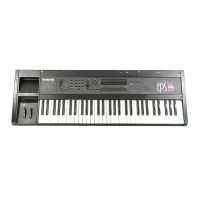Section 2 — System Control
EPS-16 PLUS Musicians Manual
Different MIDI channels should be selected for each track which you want
to receive. This can be accomplished on the EDIT/Track (see Section 3
—Instruments and Banks for more information).
In MULTI mode, independent of what sounds are selected on the front
panel, the sounds you hear will depend entirely on what MIDI channel(s)
the MIDI data is received on.
MONO Mode
MONO mode is particularly useful for driving the EPS-16 PLUS from a guitar
controller, or any other application where having up to eight independent,
monophonic channels is desirable.
The EPS-16 PLUS offers two types of MONO mode operation. In both types,
the EPS-16 PLUS will receive monophonically on eight consecutive MIDI
channels starting with the Base channel (the base channel through base channel
+7). The difference has to do with how those MIDI channels are routed within
the EPS-16 PLUS.
• MONO A — This is another ENSONIQ development intended to make
using multi-channel controllers like guitars easier. All notes and
controllers received will play whatever instruments are selected for the
note that is played You have the advantage of multiple tracks which will
respond independently to controllers received on multiple channels, but
you do not have to set up the instruments for each track separately.
• MONOB — This is the more conventional type of MONO mode. It
allows you to set up each track of the EPS-16 PLUS as a monophonic
synthesizer. This is the only way to get a different sound on each string
when using a MIDI guitar controller.
Global Controllers in MONO Mode
Global controllers are controllers sent on one channel which affect all other
channels simultaneously. They can be useful in reducing the number of MIDI
events required to achieve particular effects, and can thereby reduce the delays
sometimes associated with overloading MIDI. Some guitar controllers can
transmit global controllers, and the EPS-16 PLUS can respond to them.
In MONO mode (A or B) the base channel minus one becomes the MIDI channel
for global controllers (pitch bend, pressure, etc.). For example, if the base
channel is channel 3, any controllers received on channel 2 will be interpreted as
global controllers and will affect all voices being played. If the base channel is
channel 1, channel 16 becomes the channel for global controllers. Each track will
also respond independently to controllers sent on its own channel. For example,
each guitar string on a MIDI guitar can send independent pitch bend, while the
"whammy bar" controller could be sent on the global channel to affect all voices.
2 - 8
EDIT System•MIDI Page

